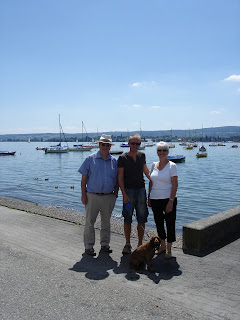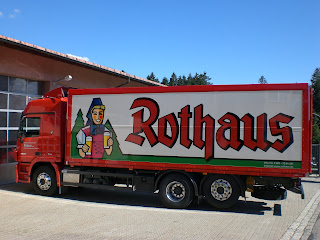View August 22nd - September 4th 2010 in a larger map
As well as being a great German compound noun, the Grossglocknerhochalpenstrasse (or ‘big bell high Alp street’), is one of the main routes through the Austrian Alps towards Italy. The road opened in 1935 and was one of the first built specifically with tourism in mind.
At 28 euros to drive along, it’s not just the road that’s steep! But we’d been looking forward to the journey for some time and it certainly didn’t disappoint. It’s an amazing drive with countless hairpin bends, tunnels and stunning mountain views.

The road is completely blocked by snow from November to May, but there was just enough left at one of the highest points of the road for a small crowd to gather and throw snowballs at each other.

One of the main stopping points is the Swarovski Observation Tower, a glass observatory furnished with telescopes that give you a close-up view of the nearby Pasterze Glacier and Austria’s highest mountain, the Grossglockner. There’s also some rather sobering information on how the glacier has shrunk over the past 75 years. There are lots of marmots up here, which make a high pitched squeeking sound and look a bit like a badger sized hamster!

The road ends in the picturesque village of Heiligenblut; so named because the church is reputed to hold a relic of the Holy Blood.

The next day we crossed the border into Italy, a country we’ve wanted to explore for some time and which first made us think about going on the road.
We spent our first week in the Dolomites, a region of huge mountains made of pale rock which gives them a striking, almost lunar feel. We dusted off the walking boots and managed a couple of decent walks.


The paths in the area are extremely popular and were filled with walkers from different countries... with their NORDIC WALKING POLES!! One of the walks took us up to the base of the Tre Cime di Laveredo, a strange mass of rock with three sharp peaks, and the nearby refuge. Refuges give hikers somewhere to sleep so they can complete high level walks without having to drop back down to lower levels. They’re more like a basic hotel than the rickety old shack you might imagine!

While in Cortina we had a chat on Skype with some friends who dared to have a get together in London without us! It was great to see them all in Sharon’s kitchen. We’re often quite loud when we get together: let’s hope the campsite didn’t mind overhearing our raucous conversation.

We left Cortina on the Great Dolomite Road, another amazing mountain road with a number of high passes and stunning views. We stopped halfway along at the Falzarego pass and, after another walk, decided to stay the night. Waking up on August bank holiday Monday to a blizzard was quite odd! It snowed for a good hour and there was quite a covering.


After the cold of the mountains, arriving at the northern shores of Lake Garda and being able to strip down to T-shirts and shorts again was quite a relief! Garda is Italy’s largest lake at 52km; so large that it actually alters the local climate making it milder and sunnier.

The road that runs down the western shore of the lake is quite amazing. Much of the first few miles from Riva del Garda is in tunnels, which give only an occasional glimpse of the lake. The tunnels are quite narrow so meeting a coach coming the other way can be quite exciting!

It’s easy to find picturesque villages with amazing views further down the lake, such as Gargnano and Salo with their beautiful lakefront promenades. Charlie loves swimming and took the opportunity to practice her diving here...
Verona was the first Italian city we visited. The city centre is beautiful, with its bustling cobbled streets and piazzas, impressive Roman arena and more modern(!)Romanesque buildings.

Shakespeare and opera are the big draws here. Although he never visited, Shakespeare set Romeo and Juliet in the city (the Montagues and Capulets are based on real families). Juliet’s balcony is one of the busiest places in town. You can queue to have your photo taken on it, if you don’t mind a couple of hundred people watching you from below.

The Roman arena is an impressive site; the third largest of all Roman amphitheatres and now the host of a famous opera season every summer renowned for its staging of Aida.

In fair Verona we also gave a wide berth to the overwhelming number of nightmares that are ‘living statues’! Quite why these people feel the need to paint themselves silver, create a tent-like costume from an old bedsheet, and terrorise innocent tourists is anyones guess.

After a quick stop at the pretty fortified town of Soave (wonder why we stopped there!), we headed on to a wild camping place we’d heard about near Venice. And it turned out to be just perfect!






















